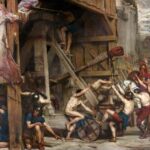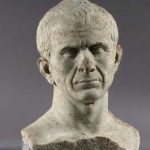The Tower of Hercules (Torre de Hércules) is located in Spain, in the city of A Coruna (official name in Galician). It is the only Roman lighthouse that has survived to our times and the oldest still operating lighthouse in the world.
Its height is 68 meters due to the reconstruction and expansion from the end of the 18th century, of which 37 meters have been preserved since antiquity. So it is one of the tallest buildings erected by the hands of the Romans that we can admire today. According to later legends, its name comes from the Greek hero who came here by barge, and the lantern was built in the place where he buried the bones and skull of Geryon, whom he killed during the tenth job. A Coruna itself is located in the place where the Roman port of Brigantium once stood, from which the invasion of Britain was planned. In the Roman times, the tower was built on a circular plan and was surrounded by external stairs.
It had 3 floors, 4 rooms on each. The illumination was achieved with a large stone oil lamp, the light of which was reflected and amplified by polished surfaces. Foundations with an inscription dedicated to Mars Augustus have been preserved:
MARTI /
AUG[USTO] SACR[UM] /
C[AIUS] SEVIUS /
LUPUS /
ARCHITECTUS /
AEMINIENSIS /
LUSITANUS EX VO[TO]
Thanks to her, we know the name of the architect: Caius Sevius Lupus, from Aeminium (today’s Coimbra), a Lusitan. However, there are disputes whether he was the creator of the lighthouse itself or just the foundations on which the statue of Mars may have been located. There are two main hypotheses for the dating of the tower itself. Both refer to the inscription, the question of the dedication to Mars suggests that it was created during or shortly after the wars. This area has had two encounters with armed conflicts. The first is the Cantabrian War, the second is the conquest of Britain. The dating of the foundations to the times of Octavian Augustus works in favour of the first one. It is not certain, however, whether the lighthouse itself was built in the same period. Most researchers are in favour of the time of Trajan. The accounts of Pliny the Elder and Strabo, who described these regions in the first century CE, may be indirect evidence. and they didn’t mention the Tower of Hercules.









